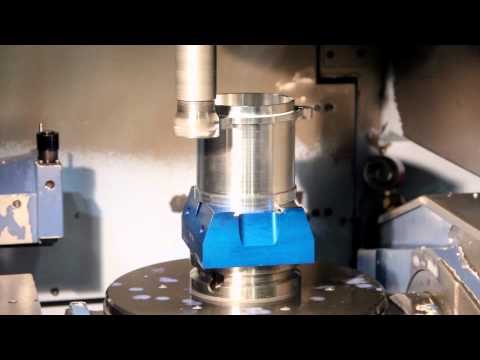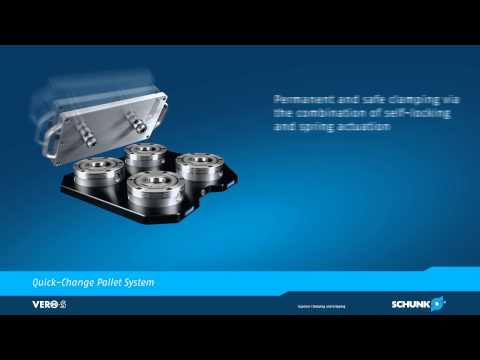Maximize Your 5-Axis CNC Operation with Quick-Change Workholding
When time is money, workholding, fixturing and setups need to be designed to take full advantage of 5-axis CNC machining capabilities.
When time is money, workholding, fixturing and setups need to be designed to take full advantage of 5-axis CNC machining capabilities.
If productivity from your CNC machining operation is the goal, then workholding and fixturing needs to be strong and it needs to work across the shop in different operations. See how companies are maximizing output and minimizing setups with the right quick-change support tools.
Many machine shops have invested in a 5-axis CNC machining center only to discover that additional investment is needed. That’s because the 6-inch machinist’s vises typically used on the shop’s existing 3-axis mills—vises that many assume will work just fine on their new 5-axis machine—don’t provide adequate clearance to machine the top and sides of a workpiece.
The vise’s relatively low profile means toolholder interference is almost assured, while its rectangular shape often does not fit on a 5-axis machining center’s smaller, often circular table.
Furthermore, a 5-axis machining center’s hourly rates are usually much higher compared to a 3-axis machine, making setup time reduction an even more important goal. As a result, a quick-change workholding strategy is almost a prerequisite for 5-axis machining, at least for those shops concerned with maximizing their machine tool’s full potential. Fortunately, the cost of dedicated 5-axis workholding and quick-change positioning systems is insignificant compared to the price of the machine tool. We talk with several workholding and fixturing tool-makers about the innovation primed for keeping 5-axis CNC machines working at optimal levels.
“Everyone in the industry knows that if you’re not making chips, you’re not making money,” says Ray Strickland, vice president of sales and marketing for Raptor Workholding Products. “This is why we started the ‘Raptor 720 Challenge,’ a program that helps 5-axis machining center owners and operators to utilize the full 720 hours available to them in a 30-day month.”
Strickland says that Raptor has seen tremendous growth over the past two years in the 5-axis machining market, and a number of his customers in the aerospace and medical field are very close to beating the Raptor 720 Challenge, routinely reporting 680 hours or more of spindle on-time each month. The secret, he notes, is to use workholding “designed to take full advantage of all that a 5-axis machining center is capable of doing.”
As its name implies, the “Raptor dovetail fixture” uses a dovetail-style clamping mechanism to grip a mating, pre-machined surface on the bottom ⅛-inch of a workpiece blank. When mounted atop one of the company’s circular riser blocks, this provides maximum cutting tool access to five of the workpiece’s six sides.

Source: Raptor Workholding Products
Raptor “multi-fixtures” are also available, allowing machinists to mount four or more workpieces in the machine at one time, as well as machinable “pinch blocks” and self-centering vises that can be equipped with dovetail or traditional step jaws.
“The Raptor system provides repeatability within five-tenths or so (0.0005 in.), and the different modules can be stacked one on top of the other for additional clearance and increased flexibility,” Strickland says. “Mounting a module or changing a workpiece is a matter of turning a couple of screws, so there’s minimal workholding-related downtime.”
About the only other consideration is cutting the dovetails in the workpiece blanks. Strickland notes that this operation doesn’t require much time or even a super accurate machine tool—a lot of Raptor customers will dedicate a knee mill to blank preparation—and there are companies offering this service for a small fee.
“However you go about prepping the blanks, we strongly recommend that shops follow the recommendations listed on our website, including the use of our dovetail cutters, which have been designed to precisely cut the angles and radii to match our fixtures,” Strickland explains. “Customers have been known to develop their own solutions, often resulting in less than consistent gripping.”
Go deeper. Learn about all the workholding systems used in precision manufacturing today in “How Workholding Can Improve Your CNC Lathe Operation.”
Raptor Workholding Products isn’t the only company with its feet firmly aboard the 5-axis machining movement. Brad Evans, team lead for stationary workholding at Schunk, says that success in this arena requires workholding that offers a balance of rigidity and accessibility, with a compact profile, high clamping forces and a selection of jaws able to grip the part securely and accurately.
To meet these needs, he recommends the 5-axis version of the company’s KSC-series vise.
“We have self-centering and dual-station models available,” he says. “All grip on a 3-to-4-millimeter-wide area along the bottom of the workpiece, and we have an option for reversible, serrated jaws that penetrate into the material, so there’s no pre-machining necessary.”
The vise uses a tongue-and-groove construction to minimize jaw lift and is sealed internally to prevent contamination. It also provides one of the highest gripping forces available for a vise of this size, according to Schunk.
Go a little deeper. Learn from “4 Under-the-Radar Tips for 5-Axis CNC Productivity.”
Evans says the jaws on the KSC vise can be swapped out very quickly, but to further reduce setup time and significantly increase flexibility on 5-axis machining centers and throughout the shop, a quick-change pallet system can also be used.
Using a retention knob and mating doughnut-shaped receiver, the “VERO-S” pallet system, for example, offers manual or automatic activation, repeatability better than 0.005 millimeters (0.0002 inches), and is suitable for a broad range of machining applications.

Source: Schunk
“The VERO-S is very flexible,” Evans says. “We have multiple sizes and configurations available, so you might attach a single VERO-S knob directly to the workpiece, mount a pair or more of them to a vise, a pallet, a chuck—pretty much anywhere. It’s accurate enough that you can release the clamping mechanism mid-cycle, take the part over to a CMM to inspect a feature, then drop it back into the machine and hit cycle start.”
The VERO-S can go from a 5-axis machining center to a 3-axis to a lathe or EDM, all without refixturing the workpiece, according to Schunk. It can also be set up offline, so workholding changeover is literally a matter of seconds. Just drop it in and go, explains Evans.
How many hours can you get out of your 5-axis CNC machine? Talk about it in the metalworking forum.



